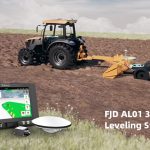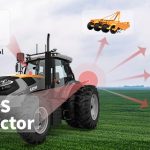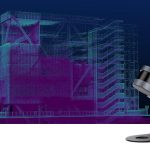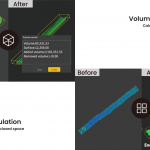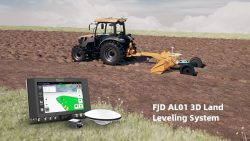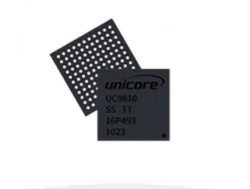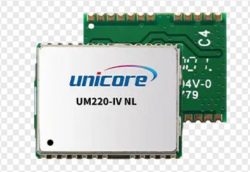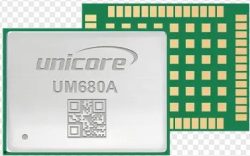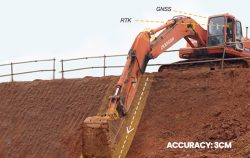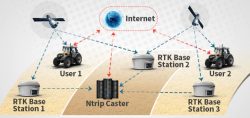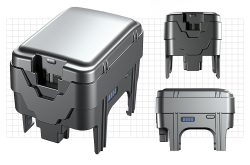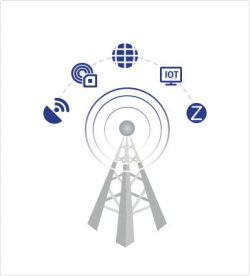Why GPS Land Leveling is Favored in Precision Agriculture?
Land leveling plays a determinant role in the reduction of water use and the increase of land and water productivity in agriculture.
land leveler for tractor
With the development of technology, precision land leveling has been widely used. While the laser land leveling system is the most common precision land leveling system, the GPS land leveling system has been gradually applied in recent years because of its unique advantages.
What is Land Leveling?
Land leveling is a process of smoothing and grading the land to a uniform plane surface at grade (zero slopes). Modifying the slope of the land to a planned grade of land leveling is also called land grading. This operation is usually intended to eliminate minor irregularities rather than change the surface’s general topography.
skid steer land leveler
Land leveling is used in agriculture to create the topographic surface or slope needed for crop growth, improved irrigation and drainage, and the effectiveness of tillage operations. Modifying the field’s surface to the desired grade makes it more suitable for irrigation.
The Benefits of Land Leveling in Agriculture
Land leveling is an essential prerequisite for agricultural land preparation, good seedbeds and land remediation. It is also one of the main factors affecting spatiotemporal yield variability (Simmonds et al., 2013). The unevenness of the field can lead to disproportionate water distribution, which hinders crop growth while increasing the use of seeds, water, fertilizers and pesticides.
The main benefits of land leveling are:
1. Increasing yields
Good field leveling will significantly improve yields. Relevant experimental information shows a strong correlation between land leveling and crop yields.
2. Reducing weeds
Good land grading improves water coverage. It reduces weeds by 40% and reduces weeding time.
3. Increasing farming area
Good land leveling increases the farming area and improves operational efficiency by getting larger fields. When the farming area rises from 0.1 to 0.5 ha, it is enlarged by 5%-7%.
Laser land leveling
4. Improving water utilization
Good field leveling can reduce the amount of water needed to grow a crop (by up to 10%). The larger the elevation difference of the rice field is, the more water is needed to achieve water coverage.
Precision Land Leveling
Land leveling with high accuracy (standard accuracy: 2-3 cm) is called precision land leveling. Precision land leveling has been proven to be highly beneficial to agricultural production. It minimizes farming operating costs, saves water for irrigation, ensures uniform seed germination, improves fertilizer use efficiency and increases crop yields.
Currently, the precision land leveling systems on the market are mainly based on laser technology and GPS precise positioning technology. The laser precision land leveling system is the most common type, and many reports and studies are based on this technology. The GPS precision land leveling system has only begun to develop in recent years. According to the existing data, it performs better than the laser land leveling system.
Laser land leveling
Laser land leveling is one of the most important technologies available to farmers and is part of the modern agricultural irrigation systems.
A laser receiver is installed in the tractor leveling blade to receive the laser transmitter’s emitted laser. The leveling information is obtained by a control terminal mounted on the tractor cab to raise or lower the leveling blade. Thus, the entire field is leveled to produce a precisely graded, flat surface ready for planting.
There are many research projects that study the impact of laser land leveling on agriculture. These projects present rigorous information on the benefits of laser land leveling to agricultural production.
PIPIP (Punjab Irrigated-Agriculture Productivity Improvement Project) uses laser land leveling technology. The final report of the project shows that the use of laser land leveling has the following impacts on agriculture:
– Saving irrigation time: 25.1%-32.1%
– Increasing irrigated area: 34.5%-42.0%
– Improving crop yields: 10.7%-12.9%
– Reducing farm cultureable waste land: 2.10%
According to a study published by International Maize and Wheat Improvement Center (CIMMYT), National Agricultural Science Center (NASC), and Complex, Borlaug Institute for South Asia (BISA), compared to traditional land leveling, the use of laser leveling reduced irrigation time by 47-69 hours/ha/season and increased yields by about 7% in rice planting. For wheat planting, it reduced irrigation time by 10-12 hours/ha/season and increased field yields by 7-9%.
GPS land leveling
The laser land leveling technology has been widely used in agriculture, but problems such as limited operating range and poor environmental adaptability have hindered the development of land leveling operations. GNSS containing GPS, GLONASS, BDS and Galileo can provide all-weather elevation information. GNSS combined with RTK technology can output elevation information with 2.5cm accuracy to meet the needs of precision land leveling operations.
GPS land leveling
GPS land leveling solves some of the problems of laser land leveling. The main advantages are:
Suitable for large farm
Due to the curvature of the earth, light incoherence, and temperature dependence, the typical range of laser land leveling systems is less than 0.91km (3000 feet), which is very small compared to the average size of an agricultural farm. According to reported information, the accuracy of GPS land leveling is essentially unchanged over a range of 3 km from the base station, making it suitable for large farms.
All-weather operation
Laser land leveling cannot be used when visibility is low (e.g., at night or on foggy days). GPS land leveling is weather independent and can be used 24/7 to help farmers complete their land leveling work quickly. According to research, it is 40% more efficient than laser systems.
FJD GPS Land Leveling System for Agriculture
FJD AL01 3D land leveling system is a precision land leveling system based on GPS and RTK technology. It features switchable load modes: precise leveling mode and wasteland reclamation mode. The accuracy of the precise leveling mode is 2.5cm.
FJD AL01 3D land leveling system
The most brilliant functions of the FJD GPS land leveling system are terrain digitalization and integrated field survey. These functions minimize land leveling costs and help operators level land easier.
Terrain Digitalization
1. Real-time Cut/Fill Map
2. Speed Display
3. Area Metering
Integrated Field Survey
1. Benchmark Auto-setting / Manual-setting
2. Slope Benchmark Setting

